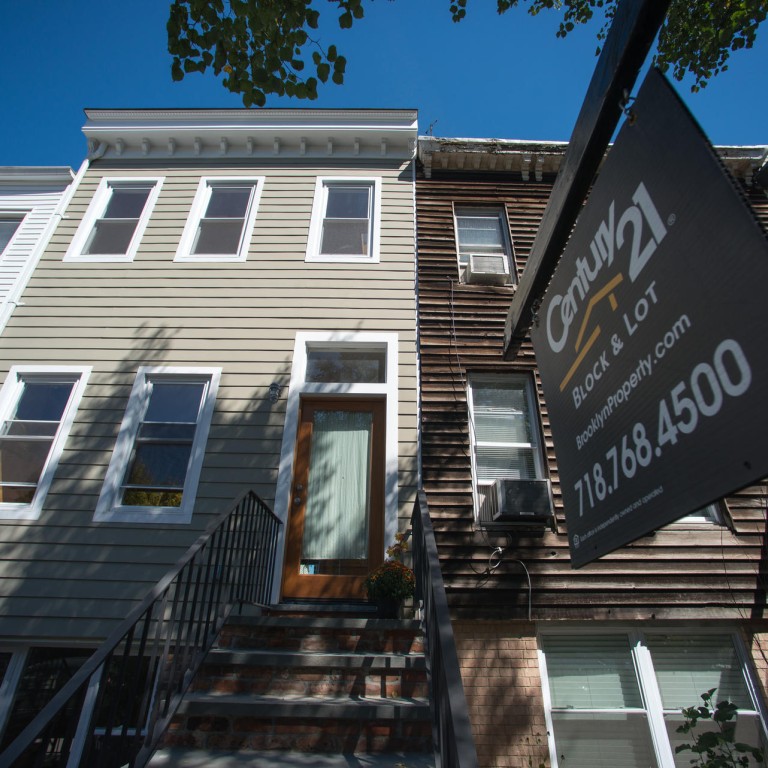
Buying still cheaper than renting in US thanks to Fed's support for loans
Central bank's extension of backing for US mortgage market means borrowing costs remain about a third cheaper than renting
Kenyatta Harper, a freelancer for advertising agencies, is trading the one-bedroom Brooklyn, New York apartment she's renting for US$1,600 a month for a two-family home nearby that cost her about US$600,000.

For New Yorkers like Harper, buying is still more than 20 per cent cheaper than renting, even after mortgage rates reached a two-year high last month, according to real-estate data provider Trulia.
The firm calculates that in the 100 largest US metro areas, home ownership is a better option with borrowing costs about 28 per cent less than the 20-year average.
And it is a scenario that will probably be prolonged after the Federal Reserve unexpectedly extended its support for the mortgage market.
"Rising mortgage rates have been affecting housing markets across the country," said Jed Kolko, chief economist at San Francisco-based Trulia.
"If rates rise more slowly or even fall because of the Fed's decision, it would take longer to reach the tipping point when renting starts to become cheaper than buying."
The central bank announced it would keep purchasing US$85 billion of bonds a month, saying it needs to see more signs of lasting improvement in the economy before reducing purchases.
Since Fed chairman Ben Bernanke had indicated in May the Fed may slow its buying of government and mortgage bonds, the average rate on 30-year home loans has risen more than a percentage point from 3.35 per cent, according to Freddie Mac data.
Prices across the US rose 12.1 per cent in June from a year earlier, according to the S&P/Case-Shiller index of 20 cities, helping narrow the cost differential between owning and renting.
Buying is now 35 per cent more affordable than renting, compared with a 45 per cent difference a year ago, said Trulia.
For buyers in Orange county, California, the New York area, New Jersey and San Diego, the cost of ownership is cheaper than renting by at least 20 per cent.
In Honolulu, the affordability gap has narrowed faster, making it 10 per cent less expensive to buy than rent, compared with 24 per cent last year.
In San Francisco, where home values gained 24.5 per cent in June from a year ago, Trulia calculates owning is now cheaper than renting by just 9 per cent, compared with 28 per cent a year ago. San Jose, California, where it is 4 per cent cheaper to buy, is closest to reaching a tipping point, the data shows.
Buying a home is most affordable in Detroit, Gary, Indiana, Memphis, Tennessee, and Cleveland, according to Trulia.
For renting in New York to become cheaper than buying, 30-year mortgage rates would need to rise to 7.5 per cent and in Orange County, California borrowing costs would need to be 7 per cent.
"House prices in most of the country are very low compared to what they were during the boom years," said Mark Goldman, a mortgage broker at C2 Financial in San Diego.
"Once you get into a 30-year loan, your costs are set. You can't say that about renting. You don't know what rents are going to do."
Demand for rentals has been rising since about 7 million households have already lost properties through foreclosure or by selling for a loss since 2007, according to RealtyTrac.
The US home ownership rate fell to 65 per cent this year, the lowest since 1995 and down from 69.2 per cent in 2004, according to Census Bureau data.
Potential homebuyers have also had to navigate the tightest lending conditions in two decades with higher down payments and credit scores required.
In areas such as New York and San Francisco, rental prices have also been driven higher as limited inventory in the sales market fuelled competition among tenants.
More costly home loans have threatened to restrain the housing revival that has been a mainstay of the economic expansion.
A report showed builders began work on fewer homes than forecast by economists in August.
Homebuilder shares that had slumped since May jumped the most in two months after the Fed said it plans to continue its monthly bond purchases at the same level to keep rates low.
James Zeumer, head of investor relations at Michigan-based PulteGroup said the run-up in borrowing costs could hurt first-time buyers.
A half-percentage-point interest-rate rise means "there will be some of them that will be out of the game", he said. That could mean more demand for rentals.
Across the US, rents on apartments and single-family homes rose 3.5 per cent in August from a year earlier, according to Trulia.
In Brooklyn, where Harper is seeking to lease part of her home later this year, the median rental price increased 4.6 per cent in August from a year earlier to US$2,850, the highest in more than five years.
Harper, a Seattle native, wants the best of both worlds. She's planning to rent half of her house for about US$2,200, after fixing it up with funds she secured from a renovation loan.
"In theory, my mortgage will always go down and rent will go up," she said. "It's an investment that I see being long term."

